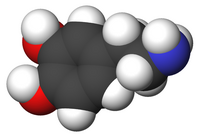
Photo from wikipedia
Abstract Introduction Older patients taking a dopamine receptor blocking agent (eg, first- or second-generation antipsychotic) have an increased risk for tardive dyskinesia (TD), a persistent and potentially disabling movement disorder.… Click to show full abstract
Abstract Introduction Older patients taking a dopamine receptor blocking agent (eg, first- or second-generation antipsychotic) have an increased risk for tardive dyskinesia (TD), a persistent and potentially disabling movement disorder. Valbenazine, a selective and potent vesicular monoamine transporter 2 inhibitor, is approved for once-daily treatment of TD with no dosing adjustments required for older patients. This analysis of valbenazine clinical trial data, which is the first to evaluate an approved TD medication in a population ≥65 years, was conducted to better understand treatment outcomes in older patients. Methods Data from two 48-week long-term studies (KINECT 3-extension, KINECT 4) were pooled and analyzed in older (≥65 years) and younger (<65 years) participants. Analyses based on the Abnormal Involuntary Movement Scale (AIMS) total score included: mean change from baseline (BL); clinically meaningful response (≥30% improvement from BL [AIMS-30%]); and protocol-defined response (≥50% improvement from BL [AIMS-50%]). Additional analyses included response thresholds for Clinical Global Improvement-Tardive Dyskinesia and Patient Global Impression of Change as follows: rating of “minimally improved” or better (score ≤3) at week 48 (CGI-TD≤3, PGIC≤3); rating of “much improved” or “very much improved” (score ≤2) at week 48 (CGI-TD≤2, PGIC≤2). Results AIMS outcomes in the older subgroup were generally comparable to (or better than) outcomes in the younger subgroup and overall study populations. In participants ≥65 years, pooled AIMS results indicated substantial improvements in TD movements with valbenazine 40 mg (n = 8) and 80 mg (n = 20): mean change from BL (−6.4 and −9.8 [for 40 and 80 mg, respectively]); AIMS-30% (75% and 95%); AIMS-50% (75% and 85%). CGI-TD and PGIC response rates indicated that clinician- and patient-reported global improvements were also substantial in the older subgroup: CGI-TD = 3 (88% and 100% [for 40 and 80 mg, respectively]); CGI-TD = 2 (88% and 95%); PGIC = 3 (88% and 100%); PGIC = 2 (75% and 90%). Conclusions These analyses, which are the first to evaluate long-term valbenazine effects in patients ≥65 years, indicate that older study participants had clinically meaningful and substantial improvements in TD that were comparable to (or better than) those in younger participants. Funding Neurocrine Biosciences, Inc.
Journal Title: CNS Spectrums
Year Published: 2022
Link to full text (if available)
Share on Social Media: Sign Up to like & get
recommendations!